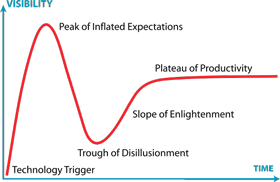GUEST POST: this is a guest post by Saad Hameed (@KaizenSaad), an experienced marketing operations manager and founder of the Marketing Automation Association LinkedIn Group.
 The CEO/CFO of your organization may be asking you to measure Marketing Campaign ROI to determine marketing’s contribution to revenue. The question is straight forward, yet what you may have already discovered is that the answer on what to measure and how to measure is not simple.
The CEO/CFO of your organization may be asking you to measure Marketing Campaign ROI to determine marketing’s contribution to revenue. The question is straight forward, yet what you may have already discovered is that the answer on what to measure and how to measure is not simple.
In B2B, a prospect doesn’t convert into a customer in a single interaction as is often the case with e-Commerce. Usually, it takes several interactions in the prospect lifecycle that help conversion from prospect to customer. This complex lifecycle makes it difficult to track and report on ROI for the various campaigns that touch prospects, especially at the granular level. In addition to determining the ROI for campaigns, additional ROI related questions are asked such as the ROI by channel (Webinar, SEM, Content Syndication, etc.) and by vehicle (Email, Print Mail, SMS, Survey, etc.). Yet these questions are difficult to answer without costly manual analysis. What you need is a solution that will properly track the influence of marketing campaigns on the funnel and also the accurate attribution of revenue to marketing campaigns. The benefits of such a solution are:
- Highly accurate measurement of marketing contribution to revenue generation
- Significantly improved campaign management as a result of deeper visibility into performance
- Time cost savings due to elimination of need to do painful manual analysis
In order to provide a better explanation of how these benefits would be accrued by your marketing organization, I would like to start by providing a more detailed definition of Campaign Attribution and Campaign Influence and why properly measuring these are critical to achieving success for your marketing organization.
Campaign Attribution:
In order to report on Campaign ROI, the first key concept that we need to define is Campaign ROI Attribution i.e. what percentage of bookings from a deal should be attributed to any given campaign. Should the bookings be attributed to the first campaign that generated the first lead into a deal or maybe the last campaign that touched it or maybe it should be equally distributed across all campaigns that touched a deal? Determining an accurate method of revenue attribution is typically very difficult. Consider this scenario, you may be using the first and last campaign attribution model which splits the revenue between the first and last campaign that touched a deal. Now suppose for a new customer win, the first campaign was an awareness-based campaign utilizing SEM and the last campaign that touched this customer was a webinar. However, there was a tradeshow that highly influenced the prospect, yet utilizing your current attribution model the tradeshow campaign would not be attributed any revenue. In the end you would not be attributing credit where it’s truly due. At the end of the day, whichever campaign attribution model you choose is the one you would be held accountable to and this further intensifies the need to track all campaigns across the lifecycle for all deals.
Campaign Influence:
Regardless of what your campaign attribution model is, tracking all campaign responses will tell you which campaigns a given prospect was influenced by. So Campaign Influence measurement focuses on all campaigns that any prospect is responding to. It tells us what campaigns are helping the prospect move closer to making the purchase decision. This measurement is a holistic approach and it helps provide insights that typical Campaign Attribution models may not be able to give. So for example, it would show the influence of educational webinars that your prospects attend during the mid-point of the prospect lifecycle. Now if you were using a first and last touch campaign attribution model then these educational campaigns would not have revenue attributed to them, yet they are critical part of the prospect lifecycle. The Campaign Influence model would capture this data and provide the necessary insight to marketing and company leadership on the value of these campaigns. Otherwise these campaigns may be sidelined in favor of campaigns with a higher ROI based on the attribution model. Aggregating data on campaign influence will also tell you what campaigns are effective in nurturing a prospect and what campaigns are ineffective. So in a sense, it is as equally important to measure Campaign Influence as it is to measure Campaign ROI.
Summary
Given the complex nature of the B2B prospect lifecycle, building a solution that can properly track these metrics as they relate to your specific business situation is necessary. This solution will help provide a deeper understanding of the marketing campaign performance thereby helping in optimizing your marketing campaigns. This solution will also help you provide your CEO/CFO with the necessary reports that they can rely on to understand marketing’s contribution to revenue generation.

